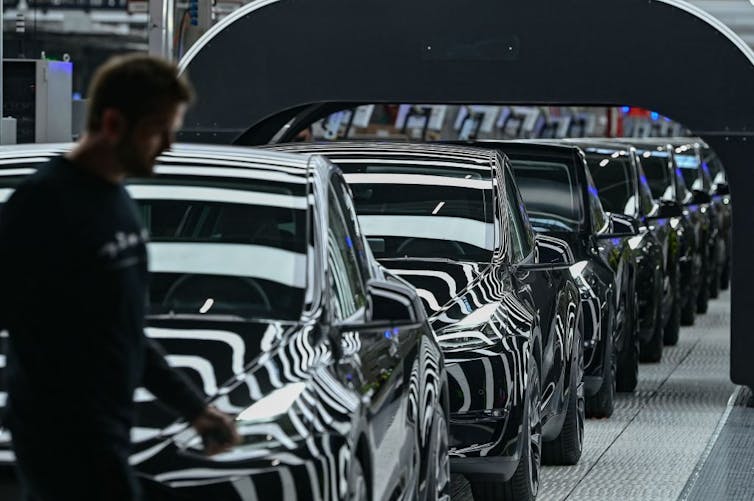US government tries to rein in an out-of-control subscription economy
It’s never been easier to sign up for subscriptions – and they’ve never been harder to manage.

Signing up for a subscription to a streaming service or newspaper has never been easier.
Canceling it, on the other hand, can be a cumbersome journey involving phone calls, letters or finding the option to cancel buried in a remote menu on an app.
And that’s if you remember to cancel in the first place.
Now, thanks to a new rule passed by the U.S. Federal Trade Commission, you may have an easier time getting rid of subscriptions you no longer want.
The rule aims to make canceling a subscription as easy as setting one up. The Federal Trade Commission refers to it as “click-to-cancel” under the logic that one click should be able to cancel a subscription.
It will go into effect on April 14, 2025.
The move updates a 1973 regulation called the “Negative Option Rule,” which governed subscription services for products like magazines or book-of-the-month clubs — physical items sent over and over. The phrase “negative option” refers to the fact that a subscriber, under the rules of the service, doesn’t need to do anything to remain subscribed; if a customer fails to cancel a subscription, a company can charge customers for another year. Silence is acceptance.
The 1973 rule only regulated “prenotification” subscriptions, in which a service would send subscribers a product and, if no action were taken, the customer was responsible for paying for it – a model that Columbia Records used for its Columbia House Record Club, which would periodically send music to subscribers and charge them for it if they didn’t return it.
The new rule requires companies that sign up customers online to allow customers to cancel online. Some companies have been forcing customers who had signed up online to cancel over the phone or in person. Under the click-to-cancel rule, companies will no longer be able to force customers to cancel in a different manner.
But I do wonder if this rule is merely a Band-Aid on a broken leg, particularly since more and more companies are starting to see value in making sure customers get locked into regular payments – and, in some cases, never fully own what they buy.
Unending consumption
According to the 2021 Subscription Economy Index, the subscription economy had grown by 437% since 2012. And as subscriptions mount, it can be difficult to remember them all, particularly since they usually operate through automatic payments.
Subscriptions services include mainstays like newspapers and magazines. But now there are razor blade, video game, software and meal subscriptions. BMW even briefly required subscriptions in some countries to use features in their cars, such as heated seats, before backing down amid an outcry.
It’s all part of a broader shift toward what, in my book on streaming, I call “unending consumption”: a business model based on the buyer’s constant consumption.
It’s constant because consumers pay a recurring charge on autopay. It’s consistent because the price is relatively stable.
Companies favor inertia over churn
You can see why this business model has companies salivating.
Most businesses have what’s known as a “high churn rate.” In other words, a high percentage of their customers only buy from them once or twice before stopping.
Subscriptions, on the other hand, give companies a stream of revenue. In business, this is called “inertia,” because once someone subscribes to a service, they tend to continue subscribing.
Before digital streaming, the average music fan spent roughly $45 per year, adjusted for inflation, on CDs, tapes and records. A Spotify subscription costs $120 per year. And what happens if you pay for Spotify, but don’t use it much during a given month? Spotify receives that $10 as surplus value.
It’s not just media companies turning to subscriptions. In the electric vehicle industry, owners increasingly need subscriptions to access certain features in their cars. For instance, Tesla requires a subscription to extend a vehicle’s battery range and use self-driving features.

Technology and society scholars MC Forelle and Aaron Shapiro have coined the term “subscriptionization” to describe how personal vehicles are being transformed into “assets that generate rents for automakers.”
Take the short-lived BMW heated seats subscription. When customers purchased their new car, their seats had the heating capability. But they needed to subscribe to a service in order for them to work: Owners could pay $18 per month, $180 per year or $415 over a vehicle’s lifetime to use it.
It’s easy to see how BMW benefits: Drivers probably only need the heated seats during the coldest months of the year. But how many will forget to cancel? This helps the automaker draw consistent income from the subscription even in warm months.
Free trials and hidden price hikes
This isn’t to say that subscriptions can’t be convenient. Paying for TV programs every time you want to stream a show would be tiresome. And purchasing a newspaper on your way to work means not being able to read it before you leave home.
However, I can’t help but see a connection between the rise in subscription-based business models and ballooning personal debt in the U.S.
Wages have stagnated for decades, beginning in the 1970s. But Americans keep paying for more subscription-based services, many of which are no longer seen as luxuries, but necessities: internet access, cell phones, Amazon Prime, Netflix, Spotify, Microsoft 365, cloud storage, and on and on. In fact, according to one poll, more than half of subscribers underestimate how much they spend on subscriptions each month, driven by a considerable amount of people who forget about their subscriptions altogether.
Click-to-cancel promises to help people manage their array of subscription services. But in my view, this fails to address a number of unfair subscription practices.
Giving people a free trial is a strategy businesses use because they know many customers will forget to cancel before the trial period ends – regardless of whether they use the service. The government could remedy this by outlawing having to enter credit card information before the purchase.
People can also end up overpaying through subscriptions that go up in cost without alerting the customers. Amazon’s “Subscribe and Save,” for example, allows prices for subscribed goods to increase, and the company won’t notify the subscriber.
According to one poll, 69% of Americans think there are already too many subscription services available. But companies are nonetheless scrambling to develop their own, whether it’s movie studios like Paramount rolling out their own subscription-based streaming services or Hewlett-Packard offering subscriptions for printer ink. Even the most popular app to manage subscriptions, Rocket Money, requires a subscription.
While click-to-cancel will make it easier to get out of byzantine subscription plans, a subscription-based economy seems poised to expand – along with all of the attendant traps to suck consumers in.
David Arditi does not work for, consult, own shares in or receive funding from any company or organization that would benefit from this article, and has disclosed no relevant affiliations beyond their academic appointment.
Read These Next
What’s at stake in Trump’s executive order aiming to curb state-level AI regulation
In the absence of comprehensive federal AI regulation, states have stepped in. The Trump administration,…
Data centers need electricity fast, but utilities need years to build power plants – who should pay?
How many data centers will be built – and how much electricity they’ll need – is uncertain. Being…
Whether Netflix or Paramount buys Warner Bros., entertainment oligopolies are back – bigger and mor
Hollywood has seen this movie before.





